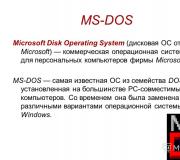MacBook won't boot (freezes when loading) - what to do. The most common problems with macbook air Macbook air problems

In one of the previous articles, I wrote about what steps should be taken. I think it would be fair if a similar article appeared about the MacBook.
After all, what could be worse than the situation, when your MacBook won't boot, and you clearly realize that all your information remains on it, the accumulation of which was spent hundreds of working hours.
In this article, I will outline an emergency action plan when your MAC flatly refuses to start. It is not at all necessary to perform absolutely all of the above steps. But we still need to act.
If your MacBook won't boot or freezes on boot, it could be due to:
- problem with hardware (HDD, memory, controller, processor, etc.);
- problem with OS X (for example, upgrading to El Capitan)
- newly installed hardware (disconnect all USB devices)
As in the case of an iPhone that won’t turn on, the first thing to do is make sure that the MacBook’s battery is not simply discharged or the charger has not failed.
If something is still displayed on the screen or even the boot process begins (which ends up stuck on a spinning disk or ends completely), you should try following the steps described below in the order they appear.
- If your MacBook is completely frozen and requires a reboot -
- Need to create a bootable USB flash drive with OS X?
- MAC stuck on white screen after OS X update -
- Read more about different boot modes -
- You don’t know what the screen that appears when you boot your MAC means -
STEP 1: Boot into Safe Mode
First, you should try booting your MacBook into Safe Mode, which limits the scans and downloadable functionality your Mac performs at startup. I don’t guarantee that after starting in this mode, your MAC will suddenly start working as before, but it’s still worth a try.
Turn off your MacBook and then turn it on while holding down the shift button. Booting into Safe Mode may take a long time (if your computer boots at all), so be patient.
If you want to know what exactly happens when you boot into Safe Mode, you can boot your MacBook by holding down shift + Command + V, which in turn will launch Safe Mode + verbose mode on your MAC.
Verbose mode is an optional operating system boot mode (including OS X, Windows, Linux), in which detailed information about loaded drivers, software and processes that occur when the computer boots is displayed on the screen.
Be patient and careful while booting your MacBook. If your computer does boot into Safe Mode, try simply restarting it from the Apple top menu.
If the MacBook now boots up in the usual way, we will assume that the situation has been corrected and now everything is fine. If the MacBook does not boot, proceed to the next step.
STEP 2: Download Disk Utility
There can be a lot of reasons why a MacBook freezes when loading. But let us check now and then discard or try to fix the reason related to your MAC hard drive problems. The easiest way to check your hard drive is to run Disk Utility(Disk Utility).
The first step is to turn off your MAC. If MacBook stuck on gray (white, blue, pink...) screen with a spinning disk, you need to force it (the computer) to turn off. To do this, press and hold the power button for 5-8 seconds.
To launch Disk Utility, you need to get into OS X recovery mode. To do this, hold down Command + R when you turn on the computer.
If everything went well, you will be taken to a screen with a title MAC OS X Utilities(see picture below). On this screen you need to click on “ Disk Utility» (Disk Utility).
Then click on the name of the built-in hard drive on the left side of Disk Utility and start the verification process by clicking on Verify Disk on the lower right side of the screen. Wait for the verification to complete.

If any problems are found, you will be prompted to correct them. Confirm your intentions by clicking on Repair Disk. After that, try restarting your MacBook again.
STEP 3: Target Disk Mode
As the saying goes, “it’s better to have a bird in your hands than a pie in the sky.” How are you doing with data backups? Well, the data that was stored on your MacBook... And now it won’t start... Sadness!
If data loss on your MacBook doesn't particularly worry you, skip straight to the next step. But if you are now in a cold sweat trying to remember whether you copied anything valuable to other disks or flash drives, then here is another gift from Apple for you - EXTERNAL DRIVE MODE.
Target Disc Mode is a special boot mode unique to MAC computers that allows you to access your computer's hard drive without booting into OS X.
Using this mode, you can save data when your MacBook does not boot for any reason.
To launch external drive mode and gain access to the contents of the MacBook hard drive, do this:
- We find another MAC computer. If you don't have one personally, ask your friends
- Connect both Macs using a Thunderbolt cable
- Turn off your MAC. If necessary, hold down the POWER button for more than 5 seconds
- Hold down the T button immediately after turning on the MacBook and hold it until the Thunderbolt icon appears on the blue screen.

You just launched External Disk Mode. This mode, roughly speaking, turns your MAC into an external hard drive. If everything went smoothly, your friend's MAC will show an additional external hard drive in Finder. Now copy and save everything you need.
When you're done with the drive, you'll need to eject it into the Finder like any other device. After that, disconnect the Thunderbolt cable and turn off your MAC computer (by holding down the power button for more than 5 seconds).
STEP 4: Reinstall OS X
If none of the previous steps brought “relief,” all that remains is to reinstall the OS X operating system. To do this, you need to boot the computer again in recovery mode, well, remember as in step 2. To do this, turn on the computer while holding Command + R.
Wait for OS X Utilities to load and select from the list Reinstall OS X. Follow the onscreen instructions until you completely reinstall the operating system.
If your MAC has not mastered the installation of OS X or has been running on a fresh operating system for a short time, most likely there are some more serious problems with your MAC.
Such problems may occur due to recently installed new hardware (memory, hard drive, etc.). Check your new hardware for compatibility with your computer.
If you have not installed anything on your MAC, you need to check the existing modules (hard drive controller, memory modules, etc.). But it is better to entrust such checks to service center specialists.
Various problems may occur while using the macbook air. What are they and how to deal with them?
Despite the fact that the macbook air is quite expensive and is produced by a company that has always been famous for its quality, many users sometimes experience problems associated with malfunctions and even breakdowns. In order to avoid problems and breakdowns in the end, you need to deal with them, then macbook air repair will most likely not be required at all.
One common problem is overheating, which can occur if the device's cooling elements are not working properly or the device is heavily clogged with dust. A special paste is placed between the processor and the heatsink, which dries out over time, leading to overheating. If you do not deal with this problem, then the central processor, video chip and any other laptop device may soon fail. The solution to this problem is quite simple; first of all, you need to clean the laptop from dust and replace the thermal conductive paste. You can do this yourself, but it is better to contact a service center to eliminate the possibility of damaging the device. Overheating can be determined by the device freezing and its body becoming very hot.
If, after replacing the thermal paste and cleaning the dust, the device still freezes, then you need to install and run special utilities that can eliminate system problems that lead to frequent freezes and poor performance.
Among the common problems is one in which the operating system stops loading. To resolve this, it is usually sufficient to reset the PRAM settings. This can be done using a special key combination. Another problem is the failure of the keyboard, this occurs largely due to liquid spilled on its surface. It is almost impossible to fix such a breakdown, because devices of this type cannot be disassembled. Yes, and doing this will simply be unprofitable. If the keys do not work, but the device is still operational, then all that remains is to connect an external keyboard and use the laptop with it. If the problem is with the keys, they can be replaced at an Apple service center, after which you can continue to use them. Problems with the macbook air can be very diverse, but in most cases you can fix them yourself without contacting Apple service center specialists.
Comments and reviews macbook air
2015-03-29 16:43:57 Anna Korolenko:
MSI has introduced two new Radeon RX 5600 XT video cards, each of which has two modifications....
Thermaltake introduced the Level 20 RS ARGB case, which belongs to the Mid Tower format. New...
ASUS has expanded its range of monitors with the VA27EHEY Eye Care model, which has a 27-inch IPS...
The Swedish company Hasselblad has introduced the lightest lens for medium format mirrorless cameras -...
The database of the popular Geekbench benchmark revealed testing results for LG's new product...
Today, users increasingly prefer equipment that is characterized by high power and portability. The leading place among such equipment rightfully belongs to MacBooks, which are the embodiment of reliability, power, beauty and performance. However, even ideal equipment can break down or fail.
Problems with a MacBook are difficult to fix on your own, since this equipment is quite specific to repair. Non-standard construction, unique spare parts, lack of a diagram for repairs - these are the main reasons why you should contact a specialized service center.
The Open IT service center technicians will help you solve any problems with your MacBook Air or MacBook Pro as soon as possible. All you need to do is call us or come directly to our office. Diagnostics of your computer will be carried out immediately, and upon completion you will find out what problems are with your MacBook and what the cost of repair work will be.
What are the most common MacBook Pro and MacBook Air problems?
Repairing Mac devices is always difficult and requires the involvement of highly qualified specialists in the process. Problems with MacBook Air and MacBook Pro most often involve improper or careless handling of the equipment. A common cause of computer failure is user inattention. For example, our office often receives equipment that has been accidentally dropped, hit, or spilled. Don’t worry if this happens to your MacBook, just dial the number of our service center, and the “Open IT” specialist will arrive at the agreed location at a time convenient for you.
Common MacBook Pro and Air problems include:
- Computer overheating. Excessive dust in the radiator and cooling fan, as well as drying out thermal paste, cause the Mac to malfunction and become overheated.
- The MacBook is running too slowly (“system slowdown”). The cause of these problems is most often the incorrect functioning of the HDD or overheating.
- MacBook doesn't detect HDD. In this case, it is necessary to replace it or replace the cable. If you are familiar with similar problems with your MacBook Air or Pro, then you should contact an Apple service center for diagnostics.
- MacBook won't turn on. Here, the cause of the problem may be problems with the keyboard, motherboard, power supply or battery.
- Mac OS won't start. Damage to the system partition or a malfunction of the hard drive can lead to problems of this kind.
- The keyboard doesn't work. Mechanical damage or liquid ingress often causes the keyboard to not work. In this situation, you will need to clean or replace this component of the MacBook.
Contacting a specialized service center will help solve all problems with your MacBook Pro or Air. If your MacBook does not work or is too slow, we recommend that you immediately contact our specialists by phone in Moscow: +7 (495) 664-55-23 . We will be happy to fix all identified problems with your MacBook!
Users of the 2013 Macbook Air have reported problems with their Wi-Fi connection. A lot of assumptions are being made in search of answers to a number of questions. Is this flaw inherent in this model at all or did it affect only one batch of goods? Is the problem in OS X or just in the operating system's network protocols?
PC Magazine reviewed some known problems and offered recommendations for solving problems for MacBook Air owners who are experiencing difficulties.
Lost Internet connection and slow data transfer
First of all, it is unclear whether most of the claims relate to loss of Internet connectivity or failures within the home network, such as when connecting to a router or other network devices such as a NAS. Judging by posts on the Apple forum, a significant number of users are complaining about Internet connection failures. Several tech reviewers and analysts have noted the slow data transfer speeds of the new MacBook Air in their articles. This points to a more local problem - perhaps within OS X or, as some observers believe, related to the network protocol used by the operating system.
However, the true cause of the failures is still unknown. Apple has made no statement about the problem, although there have been reports that Apple Genius Bar staff have been instructed to collect information... and MacBook Air computers that their owners are complaining about. But until we know more and receive confirmation from Apple, it is premature to look for someone to blame.
We spent several days testing the new 13-inch MacBook Air with the latest 802.11ac AirPort Extreme Base Station. There were no connection interruptions during testing.
Possible solutions to the problem
Update your router firmware. Making sure your router has the latest firmware is the first step to troubleshooting communication problems. Visit your router manufacturer's website, download the software for your model, and follow the update instructions.
Disable some router features. Some browsers have reported problems with TCP window scaling. This usually happens automatically in the operating system in order to improve network performance. There is no clear indication that the cause of the problem is window scaling. However, it makes sense to disable several network traffic functions that may be involved in the router.
Double NAT. For example, it is useful to check whether your network is running double network address translation (NAT). Sometimes ISPs provide users with a cable or DSL modem that already does the conversion. You could add a wireless router with NAT to it. Only one device must be configured for NAT.
Quality of Service (QoS) and other features. Try disabling Quality of Service features or program prioritization rules (if enabled). It is also recommended to back up your router configuration (many devices provide this option) and then disable features such as port forwarding rules, DMZ, and any others that you can do without without compromising security. In particular, do not disable firewall or wide area network (WAN) security, but try to disable firewall rules for specific applications.
Of course, you shouldn't disable all these features at the same time! If QoS or any other traffic-shaping feature that improves video streaming or the performance of other programs is enabled, disable it, use your MacBook, and see if that fixes the problem. If not, disable something else. A step-by-step approach is the only possible one in this case.
Restore the router to factory settings. Most users probably won't like this recommendation because it involves completely reconfiguring the router. However, sometimes it is useful to start with a clean slate. If you have the time and desire to configure your router again, try resetting it to factory settings and see how this affects the quality of your connection.
Switch the network to 802.11n mode. Many complaints are coming from users of new MacBooks running pre-release 802.11ac routers. For owners of 802.11ac routers who connect a MacBook in 802.11ac mode, we would advise replacing this mode with the old 802.11n with a 40 MHz channel. This may solve the problem for a while, at least until new information comes to light.
Try the new Airport. In our tests, there were no connection dropouts when using the 13-inch MacBook Air and the new AirPort Extreme. This does not mean that the new AirPort will solve some of the problems that the MacBook Air may have. If you're in the market for a new router and share a network with many Apple devices, the new 802.11ac AirPort is worth a look.
Airborne laptops don't have much time left.
MacBook Air - to be or not to be?
Apple recently updated its MacBook and MacBook Air lines. This was an unexpected step; according to tradition, I was waiting for an upgrade of Macs at WWDC. And it would be better if that happened, since the spring update turned out to be strange. Everything is more or less clear: it has become a little more powerful, the autonomy has been improved, the pink color would be where it would be without it. True, everyone was waiting for at least one more USB-C port, but it didn’t happen. Although, as the owner of a MacBook 12, I don’t see this as a big problem, but this is a topic for a separate post.
But they updated it strangely: now the base has 8 GB of RAM and only for the 13-inch model. Well... that's it. The hardware remains from 2015 and, as I understand it, the MacBook Air will no longer be updated this year. So why this upgrade then, if, in an amicable way, it’s time to remove this line?
I know many will disagree with me, especially owners of “air” laptops. But there are several reasons for this, which I will try to explain as clearly as possible.
Why MacBook Air is good

But before we bury Air, let's think about what its advantages are. And there are only two of them:
1. MacBook Air is the entry ticket for those who want to join the world of Apple and buy their first Mac. It is relatively inexpensive, allowing you to try the system without investing a lot of money (although due to the exchange rate, everything has become less clear-cut).
2. MacBook Air is a compact laptop with excellent hardware. This is a workhorse that can handle most tasks. You can take it with you everywhere, it works for a long time and never fails.
All this is great, but the picture changed when the MacBook 12 was introduced. It has a gorgeous screen, great sound, and it has become even thinner and more beautiful. At the same time, the range of Apple laptops has grown to indecent sizes, and the Air is clearly the weak link here.
Why the MacBook Air will die
Reason 1: it has a terrible screen

Having a screen with a resolution of 1440 × 900 in 2016 is simply indecent. I used a MacBook Air 11 for a long time, then I bought a 13-inch model. Everything is fine, but it’s impossible to work on it for a long time, your eyes get tired. And the color rendition is not so great.
Many were expecting an updated MacBook Air last year with a Retina display and thinner frames, but they presented just a MacBook. And it is he who will replace the “air” line.
Reason 2: Outdated design

MacBook Air design remains unchanged already 5 years. Despite this, it still looks good: a minimalistic unibody case, the apple glows. It’s cool, but after 5 years it’s all become boring, I want something new and interesting. I would like to remove the frames around the screen, make it even thinner, and add new colors.
And Apple did it - MacBook 12. And this year, at WWDC 2016, it will do the same with the MacBook Pro. It turns out that Apple itself is no longer interested in the Air line.
Reason 3: it's time to reduce the model range

Apple currently offers 12 (!!!) MacBook models. See for yourself: two MacBook 12, four MacBook Air and six MacBook Pro (a MacBook Pro without Retina is still on sale). And custom modifications are still not available for us. Choice is always good, but Apple is clearly having problems with rationalization right now, and this also applies to other company products.
Among the 12 models, the Air is clearly the weak link, and Apple understands this, since it released such a strange update.
What will replace the MacBook Air?

Instead of MacBook Air 11 and 13, MacBook 12 and 14 will come.
1. Now the MacBook 12 is being sold as a premium product, but soon the cost of components will drop and it will be able to replace the Air 11. It will become that entrance ticket to the world of Apple, it just needs to add more power and bring down the price tag. A lightweight, stylish laptop that can handle most everyday tasks.
2. There have been rumors about the MacBook 14 for a long time, and they even seem to promise it at WWDC 16. If the MacBook 12 is not enough, you need a larger screen and better performance - take the 14-inch model. It will replace the workhorse Air 13 and will become a more productive version of the two-wheeler.

This reorganization of the line seems logical to me. Especially after they present the firmware in the new building. The MacBook lineup will become more logical and easier for buyers. Well, the MacBook Air will remain in history as a reliable and lightweight laptop that Jobs once brought on stage in an envelope.
What do you think? Do you agree with this reorganization or will events develop differently? Share your thoughts in the comments.



